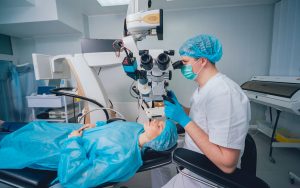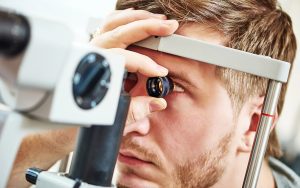Dry Eyes Syndrome
[/vc_column_text][/vc_column][/vc_row][vc_row][vc_column][vc_column_text]Dry eyes can cause lack of moisture on the surface of the eyes. It can lead to a chronic lack of lubrication as well. A consistent layer of tears on your eyes keeps them healthy. It enables you to see clearly without any issues of dryness or itching. There are three important components of normal tear fil. It consists of a lipid component (oily) that is produced by the lacrimal glands located behind the outer aspect of the upper eyelids. The mucinous (mucous) component is produced by the goblet cells and the sclera component of the eye which is white. Dry eyes can cause a feeling of scratching and irritate your eyes. Your eyes may become red due to a lack of lubrication. The constant irritation of the eyes can cause a feeling of scratchiness. Dry eyes can become irritated with the feeling of scratchiness. Constant irritation can cause it to become red and inflamed. Dry eyes can cause subtle changes in terms of significant irritation and make you feel uncomfortable. It can lead to scarring of the eyes leading to visual disturbances. It can cause Keratitis sicca with dryness in the conjunctiva region. It is the membrane that covers the white of the eye. It is also known as Keratoconjunctivitis sicca, which can affect both the cornea and the conjunctiva.What are the causes of dry eyes?
There are many potential causes of dry eyes. While working at a computer or using a smartphone or other portable digital devices, we tend to blink our eyes less frequently. Constantly gazing at digital screens can lead to greater tear evaporation and an increased risk of dry eye symptoms. Contact lenses can aggravate the symptoms of dry eyes. Dry eyes are the primary reason people stop wearing contacts. Dry eyes syndrome can occur at any age, especially after the age of 50. Staying indoors can exacerbate the dry eyes as a confined home environment with air conditioning, ceiling fans and forced-air heating systems can decrease indoor humidity. This can accelerate tear evaporation and cause dry eye symptoms. Dry climate, high altitudes, and windy conditions increase dry eye risks. Travelers susceptible to dry eye syndrome should keep their eyes hydrated, as air travel in the cabins of airplanes is extremely dry and can deteriorate dry eye syndrome mainly for frequent flyers.
Associated Risks with Dry Eyes Syndrome
Smoking can cause a serious issue with Dry Eyes Syndrome. It may cause macular degeneration, cataracts, and uveitis. Diabetes, thyroid-associated conditions, lupus, arthritis, and Sjogren’s syndrome can contribute to the dry eye problem. Antihistamines, antidepressants, certain blood pressure medications such as beta-blockers or diuretics, and birth control pills are associated risk of dry eye symptoms. Incomplete closure of the eyelids when blinking or sleeping can cause severe dry eyes. Dryness can lead to a corneal ulcer if left untreated. Lagophthalmos can cause excess evaporation of the tear film due to incomplete closure of the eyelids. They can cause natural aging, eye infections, and nerve damage due to trauma or surgical repair of the eyelid (cosmetic blepharoplasty).
Exacerbating Factors Associated with Dry Eye Syndrome
Dry eyes syndrome can be resolved before laser-assisted in situ keratomileuses (LASIK) surgery. It is recommended that patients with dry eyes should resolve dry eyes syndrome first to achieve the best LASIK results. Treatment procedures for dry eyes can vary and can be resolved in a few weeks. Antihistamines are recommended to relieve allergies associated with dry eyes. Contact lens wearers may suffer from dry eyes as well. They may experience discomfort when wearing contact lenses. It is seen that contact lens wearers suffer from watery eyes which are considered as a symptom of dry eye syndrome. Dryness on the eye’s surface can sometimes lead to overproduction of the fluid or watery part of your tears as a protective mechanism also known as reflex tearing. But this “reflex tearing” does not stay on the eye long enough to correct the underlying dry eye condition leading to damage to the eyes in the long run. In addition to these symptoms, dry eyes can cause inflammation, redness, and burning sensation. The severity of your dry eyes often will determine the type of treatment your eye doctor recommends to relieve your dry eye symptoms. Patients who undergo dry eye treatment and prevention consult ophthalmologists at the Anaheim Eye Institute, Anaheim, CA. Dry eye syndrome is a chronic and typically progressive condition, depending on its cause and severity. For some patients, dry eyes may not be completely curable. But in most cases, dry eyes can be managed successfully with the right treatment.
Treatment associated with Dry Eyes
Patients who may undergo initial dry eye treatment may experience greater comfort, fewer dry eye symptoms, and sometimes sharper vision. Dry eye disease is associated with several causes, and a wide range of treatments are used. Some optometrists and ophthalmologists may ask potential patients to submit a questionnaire based upon their symptoms before initiating dry eye treatment. Your healthcare provider may start the treatment of dry eyes with artificial tears as it is usually the first step in dry eye treatment. There are many brands of artificial tears approved by the regulatory authority that are available without a prescription. Artificial tears are scarcely available. It is challenging to find them due to a lack of availability. Ophthalmologists and optometrists in eye clinics have access to a wide range of brands and formulations available to choose from. Artificial tears and other over-the-counter (OTC) lubricating eye drops are available in a wide variety of ingredients and viscosity depending upon your kind and treatment plan. Artificial tears with low viscosity are “thin” and watery as they keep the eyes lubricated for an extended period. They often provide quick relief with little or no blurring of your vision when applied over your eyes. But often its soothing effect is short-lived depending on the severity of your eye dryness, and sometimes you must use these drops very frequently to get adequate dry eye relief. Artificial tears that have a high viscosity are more gel-like as they are prepared to enhance your vision and can provide longer-lasting lubrication. But typically, these drops cause significant blurring of your vision for several minutes immediately after you apply as your eyes take time to adjust initially. For this reason, these drops are often not a good choice for use during your workday, as you need your vision to clear and to be able to focus without any adjustment issues. You may need an immediate clear vision for tasks such as driving, as artificial gel-based tear takes some time to adjust. Sometimes high-viscosity artificial tears are recommended for bedtime use only, as they allow you to keep your eyes closed without irritation or itch.
You may consult your eye doctor as they might recommend daily use of a prescription eye drop called Restasis (Allergan) which is effective for your dry eye treatment and provide long-lasting soothing relief. Restasis does more than simply lubricate the surface of your eye as it shields your eyes from foreign debris and pathogens. It also includes an agent that reduces inflammation, redness, and pain associated with dry eye syndrome. It helps your eyes produce more natural tears as they keep your eyes lubricated and moist. It is comfortable and healthy to use and allows your eyes to regenerate tears and avoid harmful effects of dry eyes syndrome.[/vc_column_text][/vc_column][/vc_row][vc_row][vc_column][vc_empty_space][/vc_column][/vc_row]




